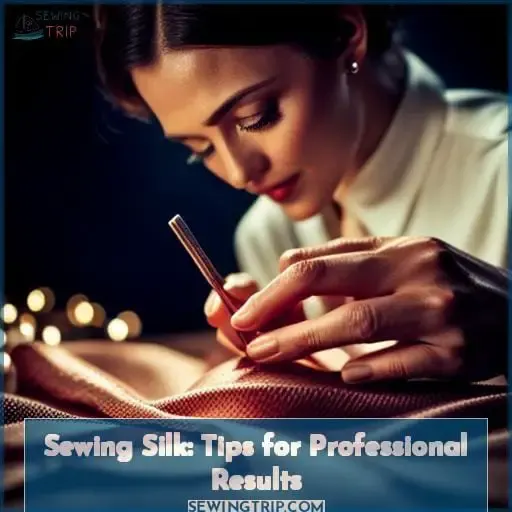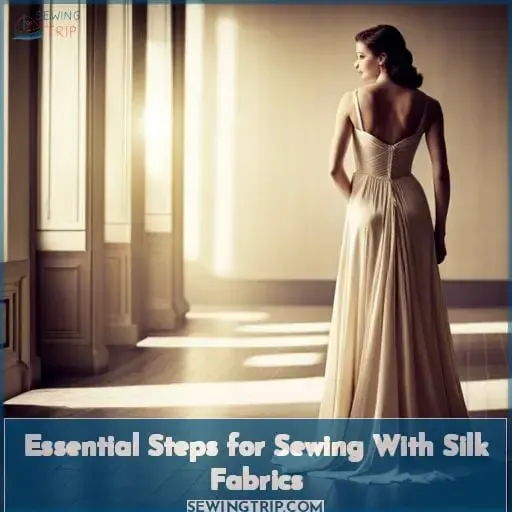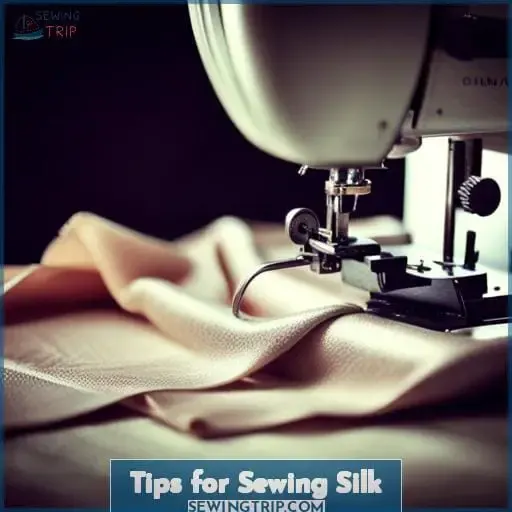This site is supported by our readers. We may earn a commission, at no cost to you, if you purchase through links.
 Sewing a beautiful garment or project out of luxurious silk fabric requires skill and patience, but with these tips, you can get professional results.
Sewing a beautiful garment or project out of luxurious silk fabric requires skill and patience, but with these tips, you can get professional results.
Working with silk is vastly different from working with other fabrics like cotton or linen – it’s very delicate and needs special care when cutting, pinning and sewing.
Here are some essential steps for achieving success while sewing silk:
- Stabilize your fabric using interfacing.
- Select the best needle size for your project.
- Choose the right thread type that won’t damage your fabric.
- Adjust machine settings for a perfect stitch every time.
With practice comes perfection! Make sure to use these tips each step along the way so that your finished product will be something truly remarkable made entirely from gorgeous silk material.
Table Of Contents
Key Takeaways
- Clean the machine and set up a work surface.
- Use sharp scissors and silk-specific pins.
- Choose a fine needle (for example, 65/9 or 70/10) for silk.
- Wash and press the silk fabric before cutting it.
Essential Steps for Sewing With Silk Fabrics
Working with silk requires patience and care. Start by preparing your workspace and tools. Clean your sewing machine and iron, and cover your work surface with a clean cloth. Use sharp scissors and pins specifically for silk to avoid snags. Select a fine machine needle like a 65/9 or 70/10 for sewing.
Wash and press your fabric before cutting. Silk is delicate and washing helps remove excess dye and the gum residue from processing. Wash in cool water with a mild soap, roll in a towel to absorb water, and lay flat to dry.
Use weights or pins while cutting to prevent shifting. Cutpattern pieces singly rather than folding fabric. Transfer any markings with tracing paper or chalk rather than pens that may bleed.
Set your machine stitch length to 2.0-2.5 mm for seams and hems. Use a fine thread in a color matching the fabric. Engage the presser foot pressure to limit feed problems on the slippery fabric. Consider hand basting trickier seams before sewing.
Reduce bulk with French seams, flat felled seams, or by grading/trimming allowances. Understitch to help seams lay flat. Make buttonholes horizontally and reinforce with gimp cord.
With care silk can be a dream to sew! Taking it slow and following these basic steps will lead to quality results.
Prewash to Avoid Water Marks
You’ll want to pre-wash your silk before starting your project to prevent water marks and stains from ironing.
- Use a mild detergent and cool water for prewashing.
- Lay flat to dry or tumble dry on low heat.
- Test for colorfastness on a fabric swatch before washing the yardage.
Prewashing allows the fabric to relax and removes any chemicals from manufacturing. This helps the silk maintain its shape during construction and pressing. Beginning with prewashed yardage leads to a high-quality finished garment.
Use Weights and a Rotary Cutter
Iron the shabby weight behind before quickly slicing with a sharp rotary cutter for suspiciously precise cutting. Utilize a rotary cutter and self-healing mat for flawless, smooth cutting of slippery silk instead of regular scissors.
Firmly secure tissue paper or pattern weights so layers don’t slide during cutting. Frequently check blade sharpness as even microscopic nicks snag silk threads. Gently handle cut edges to prevent unraveling of silk’s tightly woven threads.
Take your time – patience prevents problems when cutting couture quality material.
| Tool | Use |
|---|---|
| Silk Weights | Secure layers for precise cutting |
| Rotary Cutter | Straight, smooth cuts without fraying |
| Self-Healing Mat | Protects work surface from cuts |
| Sharp Blades | Prevent snags in fabric |
| Tissue Paper | Stabilizes slippery fabrics |
Handle silk gently after cutting to avoid fraying threads. A sharp rotary blade is vital for clean cuts without pulls or snags.
Test Fabric Pens
Make sure fabric pens don’t bleed on silk by testing them on scraps first. Some pens may leave permanent marks or bleed through delicate fabrics. Take a small piece of leftover silk and draw a few lines with your fabric pen. Allow it to dry fully, then gently wash and press the silk scrap.
Examine it closely to see if any ink bled through or left a stain. Repeating this test with a couple fabric pen options helps you select the best tool for marking seam allowances and other guidelines on your silk project without mishaps.
Avoid Permanent Marks From Pins and Needles
Trim any loose threads carefully when cutting open buttonholes to avoid leaving permanent pin or needle holes on your delicate silk fabric. When sewing with silk, select extra-fine needles and quality silk pins to prevent visible marks.
Reinforce seams with narrow strips of interfacing before stitching to stabilize the fabric. For fitting, use only silk-safe tape and patches. Hand baste with care. Choose thimbles and apply gentle pressure when hand sewing to avoid punctures.
With preparation and the proper tools, you can sew exquisite silk garments free of holes or snags.
Choose the Right Pins and Needles
Slip sharp needles and slim pins carefully when sewing skinny silk for smooth seams.
- Select fine silk pins with slender smooth heads to avoid snagging delicate fabrics.
- Use size 8-10 needles with tiny eyes and sharp points for skinny silks.
- Insert pins perpendicular to the fabric edge to minimize visibility.
- Change needles often to keep points sharp and prevent damage.
To prevent frustration, arm yourself with the right needles and pins when sewing slippery silk.
Tips for Sewing Silk
When sewing with silk fabric, it’s crucial to make adjustments for this delicate material. First, stabilize silk fabric with a lightweight fusible interfacing to prevent distortion. Then, select needles with sharper points and smaller eyes, such as Microtex or silk needles.
You’ll also want to choose the right silk thread weight and adjust your machine’s stitch length, tension, and presser foot pressure. Taking these steps for your fabric, tools, and settings helps you achieve smooth sewing and prevent frustrations like slipping, puckering or broken threads.
Stabilize Silk Fabric With Interfacing
You’ll stabilize silk’s slippery surface by gently fusing a sheer knit interfacing. This lightweight material prevents distortion without adding bulk or changing the drape. Consider a woven fusible for very delicate silk. Interfacing makes sewing with silk much easier.
| Type | Weight | Uses |
|---|---|---|
| Sheer knit | Ultra lightweight | Dresses, blouses |
| Woven fusible | Lightweight | Lingerie, scarves |
| Woven sew-in | Medium weight | Structured garments |
| Nonwoven fusible | Mid to heavy | Outerwear, crafts |
Interfacing provides the internal structure needed for successful silk projects. Select an appropriate stabilizer for your fabric’s weight and intended use. With the right interfacing, you’ll have an easier time cutting, sewing, and pressing this luxurious material.
Select the Best Needle for Silk Fabric
Before you prick your precious silks, consider choosing size 70/10 needles for smooth sailing on your sensitive fabrics.
- Size 70/10 or 65/9 universal sewing machine needles. The sharp points penetrate fabric cleanly for precise stitching.
- Size 12 microtex or quilting needles. Their thin shafts make tiny needle holes in delicate silk.
- Size 8-10 embroidery needles. Their elongated eyes accommodate silk threads and prevent fraying.
Avoid damaged needles that snag threads or leave large holes. Sharp points, fine shafts, and smooth eyes allow needles to pierce silk with ease for flawless seaming and finishing.
Choose the Right Thread for Sewing Silk Fabric
Carefully selecting your thread ensures smooth sewing and prevents puckering when stitching that sensuous silk. 100% silk thread works best, though fine cotton and thin linen threads can substitute when silk is unavailable.
Polyester tends to pucker, so avoid it if possible. Size 50 silk thread provides strength without bulk. For lighter silks, size 80 dissolves into the weave. Adjust your machine’s tension and foot pressure to prevent skipped stitches.
When hemming or finishing buttonholes, reinforce with lightweight tissue paper. The right thread helps your needle glide through silk with ease.
Adjust Sewing Machine Settings for Silk
After aligning the needle and checking tension, set the stitch length between 1.5-2mm to prevent puckering when sewing silk. The smoother the stitch, the happier you’ll be. Begin with a longer stitch length, test on fabric scraps, and reduce as needed.
60/8 and 65/9 needles glide through silk effortlessly. For lightweight silks, reduce presser foot pressure. Tissues and straight stitch plates keep layers from slipping. With the right tools, your silk will shine.
Finishes like French seams encase raw edges neatly. Quality threads promote even stitching without breakage or snagging. Precise cutting and pressing allow you to handle silk confidently. Mastery over materials is liberating.
Sewing Silk: a Challenging Task
Try gently navigating this daunting material by stabilizing with fusible interfacing, choosing the finest needles, setting stitch length precisely, and pressing carefully from behind.
Silk’s slippery smoothness can frustrate even experienced sewers. Arm yourself with the right tools and techniques, and silk’s challenges transform into creative possibilities.
Select sharp, fine needles to pierce silk’s threads without tearing.
Adjust stitch length between 1.5-2mm for stability without puckering.
Test thread tension on scraps to balance thread tightness.
Fusible knit interfacing prevents stretching; woven stabilizes seams.
Press silk from behind with a cloth, avoiding steam.
Consider Hong Kong finishes or edge stitching to control fraying. With care, silk lends elegance to dresses, blouses, and intricate embellishments.
Patience and preparation empower your next luxurious silk project.
How to Sew Silk and Get Professional Results
Before beginning your next silk sewing project, choose the right tools and techniques to achieve professional results. Select extra sharp needles, quality threads, tissue paper, and other supplies specifically designed for delicate fabrics.
Remember to stabilize seams with lightweight interfacing and adjust your sewing machine for straight stitching to prevent puckering on the silk.
Use Interfacing to Stabilize Silk Fabric
Place a soft, woven, fusible interfacing between the fabric and the needle plate before starting a project. Interfacing prevents stretching and tearing. Use lightweight varieties or silk organza for sheer fabrics.
Select needles with sharp points and small eyes. Engage a straight stitch plate to avoid ruining the delicate material. Test stitch settings on scraps. Press seams from the reverse side. Allow for extra seam allowances.
Reinforce edges with narrow strips. Your sewing skills will improve once you master interfacing application for silk projects.
Choose the Best Needle for Silk Fabric
To be a craftsperson, select the sharpest needles. For sewing silk, use Microtex or Ballpoint needles. Their slender profiles glide smoothly without snagging delicate threads. Choose lightweight, fine needles in sizes 60/8 through 70/10.
Ballpoints help fabrics like charmeuse and satin. Aim for high-carbon steel construction. Sharps pierce too aggressively, causing runs. Match needle size to thread thickness. Silk requires 60-weight polyester or cotton thread. Needles with long eyes suit these.
Silk deserves first-rate tools. Master stitching by outfitting your sewing machine properly.
Select the Right Thread for Sewing Silk Fabric
You’ll want high-quality cotton or silk thread for your delicate silk project. Choose 100% cotton threads like Gutermann or Mettler for durability and colorfastness. Fine 60/2 cotton thread has enough strength without bulk. Alternatively, use 100% pure silk threads in a fine 100 weight.
Superior’s Soie Cristale is lustrous and strong. Avoid cheap polyester thread that may snag or create heat damage. Match thread color closely to prevent visibility. Set stitch length from 1.5-2mm and maintain light tension for the best results.
Sew Silk With a Straight Stitch Plate
Using a straight stitch plate safeguards your delicate silk as you engage in creative expression.
- Install a straight stitch throat plate to support fine silk fabric.
- Adjust the plate opening to fit your needle for optimal stitching.
- Select the straight stitch on your sewing machine.
- Set your machine to a shorter stitch length between 1.5-2mm.
- Engage the needle down function for pivoting precision.
Sewing with silk requires a straight stitch plate. It guides the needle’s descent through the delicate fabric. Set your stitch length between 1.5-2mm for smooth, even stitches. Engage the needle down function when pivoting corners.
With practice, you’ll achieve exquisite results on elegant projects. Precision and perfection await your needle and silk.
Use Tissue Paper to Prevent Slipping
Slip a sheet of tissue paper under the silk as you sew to prevent the slippery fabric from sliding around. This simple trick keeps the fabric stable so it does not distort as you stitch. Place the tissue between the silk and sewing machine needle plate.
The paper provides enough friction so the silk stays flat while you sew seams. Follow the tracing lines on the pattern for precise stitching.
Prevent Puckering on Silk
Adjust your sewing machine’s tension and stitch length to avoid unwanted puckering when sewing slippery silk. To achieve silk seam perfection, loosen the tension and lengthen the stitch to 2 millimeters.
For silk stitching mastery, consider using a Teflon or PTFE presser foot and 70/10 microtex needles. To achieve flawless silk sewing, place tissue paper or stitch stabilizer behind the fabric. With knowledge and experience, you will gain elegance when sewing silk fabric. Sew silk like a professional by refining your sewing machine settings and utilizing specialty tools.
Your silk fabrics will flow beautifully when you master these techniques for preventing puckers.
What to Sew With Silk Fabric
Try pairing silk charmeuse with a long, flowy skirt to accentuate the fabric’s movement. Experts recommend using a minimum 2-yard cut for silk skirts to achieve proper drape. Silk’s delicate drape elevates fashion projects like blouses, dresses, and lightweight jackets.
For summertime style, a silk crepe de chine camisole pairs perfectly with jeans or shorts. Play with texture by combining silk with lace for romantic dresses and tops. Silk’s elegance also inspires creative home decor.
Use silk to add luxurious detail to throw pillows or table runners in your favorite hues. Trim lampshades or dress up picture frames with remnants of silk dupioni. Silk organza makes stunning overlays for curtains or canopies.
With some creativity, you can find countless ways to incorporate silk’s beauty into garments, accessories, and home decor pieces.
Conclusion
Sewing silk can be a challenging yet rewarding task. With the right tools, techniques, and knowledge, you can get professional results that’ll last for years. Knowing how to stabilize silk fabric with interfacing, select the best needle for silk fabric, choose the right thread for sewing silk fabric, and adjust sewing machine settings for silk can make all the difference.
From lingerie to t-shirt quilts, there’re so many amazing projects that you can make with silk fabric.











